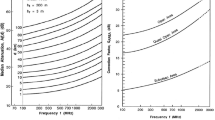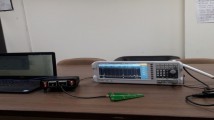Abstract
This paper presents an extensive path loss measurement campaign carried out in rural areas at 3.7 GHz, including line-of-sight (LOS) and non-LOS conditions. For this purpose, a commercially established fixed wireless access (FWA) network is exploited, operating with time-division long term evolution configuration. Furthermore, various models are examined and validated regarding their ability to predict accurately the path loss. The results reveal that the standard propagation model (SPM) achieves the best performance, thus being an attractive option for planning rural FWA links. The WINNER II and 3GPP/ITU-R models exhibit very good performance, as well. From the statistical assessment, the shadow fading follows the Lognormal distribution with a standard between 4.6 and 5.4 dB. An almost excellent fit is obtained regardless of the diverse propagation conditions in the specific area. Finally, from the model evaluation was concluded that SPM is highly recommended as the best option for a precise network dimensioning and planning.







Similar content being viewed by others
References
GPP TS 36.101. (2017). Evolved universal terrestrial radio access (E-UTRA); user equipment (UE) radio transmission and reception (Release 14), V14.3.0.
He, R., et al. (2016). Channel measurements and modeling for 5G communication systems at 3.5 GHz band. In Proccedings 2016 URSI Asia-Pacific radio science conference (pp. 1855–1858).
Chrysikos, T., Georgakopoulos, P., Oikonomou, I., & Kotsopoulos, S. (2018). Measurement-based characterization of the 3.5 GHz channel for 5G-enabled IOT at complex industrial and office topologies. In Proceedings 2018 wireless telecommunications symposium (pp. 1–9).
Liao, Y., Shen, X., Sun, G., Dai, X., & Wan, S. (2019). EKF/UKF-based channel estimation for robust and reliable communications in V2V and IIoT. EURASIP Journal on Wireless Communications and Networking,144, 1–13.
Liao, Y., Yang, X., Yao, H., Chen, L., & Wan, S. (2019). Spatial correlation based channel compression feedback algorithm for massive MIMO systems. Digital Signal Processing,94, 38–44.
Raschkowski, R., et al. (2016). Directional propagation measurements and modeling in an urban environment at 3.7 GHz. In Proceeding 50th Asilomar conference on signals, systems and computers (pp. 1799–1803).
Rodriguez, I., et al. (2013). Path loss validation for urban micro cell scenarios at 3.5 GHz compared to 1.9 GHz. In Proceedings IEEE globecom 2013 (pp. 3942–3947).
Katev, P. D. (2012). Propagation models for WiMAX at 3.5 GHz. In Proceedings electro 2012 (pp. 61–65).
Begovic, P., Behlilovic, N., & Avdic, E. (2011). A novel approach for evaluating applicability of existing empirical propagation models to coverage planning in 3.5 GHz WiMAX systems. In Proceedings 18th international conference on systems, signals and image processing (pp. 1–9).
Kun, S., Ping, W., & Yingze, L. (2008). Path loss models for suburban scenario at 2.3 GHz, 2.6 GHz and 3.5 GHz. In Proceedings 8th IEEE international symposium on antennas, propagagation and EM theory (pp. 438–441).
Imperatore, P., Salvadori, E., & Chlamtac, I. (2007). Path loss measurements at 3.5 GHz: a trial test WiMAX based in rural environment. In Proceedings 3rd international conference on testbeds and research infrastructure for the development of networks and communities (pp. 1–8).
Rimac-Drlje, S., Milanović, J., & Strešnjak, S. (2009). Receiving power level prediction for WiMAX systems on 3.5 GHz. In Proceedings IEEE wireless communications and networking conference (pp. 1–6).
Abhayawardhana V. S., et al. (2005). Comparison of empirical propagation path loss models for fixed wireless access systems. In Proceedings IEEE 61st vehicular technology conference (pp. 1–5).
GPP, TS 36.211. (2018). Evolved universal terrestrial radio access (E-UTRA); physical channels and modulation (Release 14), V14.2.0.
Sun, S., MacCartney, G. R. Jr., & Rappaport T. S. (2016). Millimeter-wave distance-dependent large-scale propagation measurements and path loss models for outdoor and indoor 5G systems. In Proceedings 10th European conference on antennas and propagation (pp. 1–5).
Erceg, V., et al. (1999). An empirically based path loss model for wireless channels in suburban environments. IEEE Journal on Selected Areas in Communications,17(7), 1205–1211.
COST Action 231. (1999). Digital mobile radio towards future generation systems, final report. Technical report European Communities, 18957.
Ericsson Radio Systems AB. (1997). EET-Ericsson engineering tool, user reference guide.
Electronic Communication Committee. (2003). The analysis of the coexistence of FWA cells in the 3.4–3.8 GHz band. ECC report 33.
Rappaport, T. S. (2002). Wireless communications: Principles and practice (2nd ed.). Upper Saddle River: Prentice Hall.
Kyösti, P., et al. (2008). WINNER II channel models, European commision, IST-WINNER, D1.1.2 V1.2. Retrieved June 3, 2019 from https://www.cept.org/files/8339/winner2%20-%20final%20report.pdf.
International Telecommunications Union. (2009). “Guidelines for evaluation of radio interface technologies for IMT-Advanced,” Geneva, Switzerland, Rec. ITU-R M.2135-1.
International Telecommunications Union. (2017). Monte Carlo simulation methodology for the use in sharing and compatibility studies between different radio services or systems. Rec. ITU-R SM.2028-2.
Moraitis, N., Vouyioukas, D., Gkioni, A., & Louvros, S. (2019). Rural path loss measurements and models for a fixed wireless access TD-LTE network at 3.7 GHz. In Proceedings 13th European conference on antennas and propagation (pp. 1–5).
Almeida, E. P. L., et al. (2018). An empirical study of propagation models for wireless communications in open-pit mines. In Proceedings IEEE 87th vehicular technology conference (pp. 1–6).
Li, H., He, X., & He, W. (2018). Review of wireless personal communications radio propagation models in high altitude mountainous areas at 2.6 GHz. Wireless Personal Communications,101(2), 735–753.
GPP TR 25.996. (2018). Spatial channel model for multiple input multiple output (MIMO) simulations (Release 15), V15.0.0.
MacCartney, G. R., & Rappaport, T. S. (2017). Rural macrocell path loss models for millimeter wave wireless communications. IEEE Journal on Selected Areas in Communications,35(7), 1663–1677.
De Freitas, P. R., & Tertuliano Filho, H. (2017). Parameters fitting to standard propagation model (SPM) for long term evolution (LTE) using nonlinear regression method. In Proceedings IEEE international conference on computational intelligence and virtual environments for measurement systems and applications (pp. 84–88).
Hata, M. (1980). Empirical formula for propagation loss in land mobile radio services. IEEE Transactions on Vehicular Technology,29(3), 317–325.
Ayadi, M., Ben Zineb, A., & Tabbane, S. (2017). A UHF path loss model using learning machine for heterogeneous networks. IEEE Transactions on Antennas and Propagation,65(7), 3675–3683.
Forsk, ATOLL 3.3.0. (2015). Technical reference guide for radio networks. Retrieved June 3, 2019 from www.forsk.com.
Östlin, E., Zepernick, H. J., & Suzuki, H. (2010). Macrocell path-loss prediction using artificial neural networks. IEEE Transactions on Vehicular Technology,59(6), 2735–2747.
Zhang, Y., et al. (2019). Path loss prediction based on machine learning: Principle, method, and data expansion. Applied Sciences,9(9), 1–18.
Parsons, J. D. (2000). The mobile radio propagation channel (2nd ed.). New York: Wiley.
Zhou, X., et al. (2015). Experimental characterization and correlation analysis of indoor channels at 15 GHz. International Journal of Antennas and Propagation, 2015, Article ID 601835.
Popoola, S. I., et al. (2017). Calibrating the standard path loss model for urban environments using field measurements and geospatial data. In Proceedings world congress on engineering (pp. 513–518).
Popoola, S. I., et al. (2017). Standard propagation model tuning for path loss predictions in built-up environments. In Proceedings international conference on computational science and its applications (pp. 363–375).
Popoola, S. I., & Oseni, O. F. (2014). Performance evaluation of radio propagation models on GSM network in urban area of Lagos, Nigeria. International Journal of Scientific and Engineering Research,5(6), 1212–1217.
He, R., et al. (2015). Characterization of quasi-stationarity regions for vehicle-to-vehicle radio channels. IEEE Transactions on Antennas and Propagation,63(5), 2237–2251.
Lee, W. C. Y. (1993). Mobile communications design fundamentals. Wiley series in telecommunications and signal processing. Chichester: Wiley.
Kullback, S., & Leibler, R. A. (1951). On information and sufficiency. The Annals of Mathematical Statistics,22(1), 79–86.
Sen, I., & Matolak, D. W. (2008). Vehicle–vehicle channel models for the 5-GHz band. IEEE Transactions on Intelligent Transportation Systems,9(2), 235–245.
International Telecommunications Union. (2018). Propagation by diffraction. Rec. ITU-R P.526-14.
Author information
Authors and Affiliations
Corresponding author
Additional information
Publisher's Note
Springer Nature remains neutral with regard to jurisdictional claims in published maps and institutional affiliations.
Appendix: Diffraction loss calculation
Appendix: Diffraction loss calculation
Diffraction loss can be calculated using many methods, such as the Epstein–Peterson, Deygout, and Bullington [35]. In the following, the single knife-edge diffraction method is utilized [20]. In this extremely idealized case, all the geometrical parameters are combined together in a single dimensionless parameter normally denoted by ν which may assume a variety of equivalent forms according to the geometrical parameters selected. Figure 8, shows an indicative paradigm of the adopted knife-edge geometry with a view to calculating diffraction loss.
The diffracted component from an obstacle between a Tx and Rx, is attenuated due to the presence of this “knife-edge”, and the diffraction loss can be calculated according to the simplified expression [44]
where ν is the diffraction parameter given by
All the parameters in (25) are expressed in meters, where h is the height of the top of the obstacle above the straight line that joins the two ends of the path, λ is the wavelength, and d1, d2 are the distances from the Tx and Rx to the obstacle, as shown in Fig. 8. Then, h can be yielded by
where hn is the obstacle height, Ht, Hr are the effective Tx and Rx heights, respectively, and re is the earth curvature, all provided in meters. The earth curvature can be calculated according to
where Re is the earth radius (6371 km).
During the measurements the coordinates of each BS and CPE locations are recorded and stored. Then, using Atoll [32], and with the help of a detailed digital terrain map, hn, d1, d2, could be determined accurately. Finally, diffraction loss is calculated applying (25)–(28).
Rights and permissions
About this article
Cite this article
Moraitis, N., Vouyioukas, D., Gkioni, A. et al. Measurements and path loss models for a TD-LTE network at 3.7 GHz in rural areas. Wireless Netw 26, 2891–2904 (2020). https://doi.org/10.1007/s11276-019-02243-9
Published:
Issue Date:
DOI: https://doi.org/10.1007/s11276-019-02243-9





